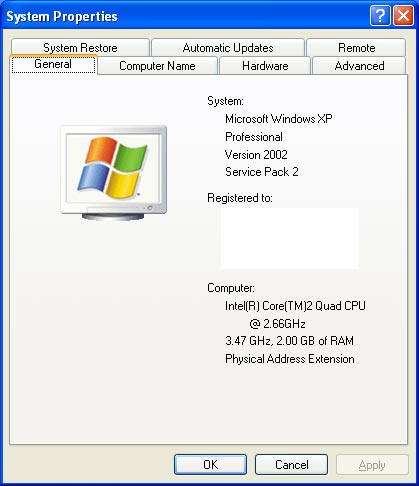Intel's Core 2 Extreme QX6700: The Multi-core Era Begins
by Anand Lal Shimpi on November 2, 2006 2:14 AM EST- Posted in
- CPUs
Using a Quad Core System
Intel's first dual core processors, codenamed Smithfield, were actually the first 90nm Intel CPUs we actually recommended. The reason being that the real world performance improvement brought about by having two cores at your fingertips was simply too much to resist, especially if you were a heavy multitasker. A big reason for the improvement in real world performance came about because of inefficiencies in the way Windows XP's scheduler handled juggling multiple threads, especially on a single core CPU. The move to dual core got rid of many of those nasty Not Responding windows when Windows' scheduler would simply never properly allocate CPU cycles to a particular thread.

Inevitably the same thread juggling problems we saw with single core CPUs would eventually apply to dual core CPUs, just with more active threads. Intel once told us that we'd run into the same sort of scheduler/CPU cycle limitations at a bit over a dozen active threads on a dual core CPU, meaning at that point, it's time for four cores.
We performed a quick test to see if we could spot the real world difference in multitasking and system responsiveness between a dual core and a quad core CPU. We took our test bed and ran as many multithreaded benchmarks as we could feasibly start without completely bogging down the system; we ran our 3dsmax, Cinebench, DivX, WME and iTunes tests all at the same time, not to see how fast they'd run, but to see how responsive the rest of the system would be with a dual core CPU vs. a quad core CPU.

On both systems we had no problems launching Explorer windows or navigating the OS while all of those tasks executed, indicating that we were no where near that saturation point where the entire system becomes unresponsive; good news for dual core owners.
We could switch between all of the running applications without running into a window that wouldn't respond, with the exception of iTunes. Regardless of whether we had two or four cores at our disposal, iTunes would only respond when it felt like it. Although the encoding task was continuing, we couldn't interact with the application without waiting a handful of seconds for it to regain consciousness.
The primary difference between two and four cores in our very heavy multitasking scenario was in the work that got done. While the 3dsmax, DivX, WME and iTunes tests all managed to inch along during our test, with a dual core setup the Cinebench test wouldn't even start until after iTunes had completed. On the quad core setup, Cinebench ran alongside iTunes, albeit at a slow pace.

It's a faint difference but it does highlight an important point - even the heaviest of multitaskers aren't likely to see a huge difference in system responsiveness with four cores vs. two. It is in the performance of individual threads, especially when you have a lot that are contending for CPU time, that you'll see a much bigger difference between Kentsfield and Conroe.










59 Comments
View All Comments
PrinceGaz - Thursday, November 2, 2006 - link
What do you mean it is "a insanely round-about way of measuring power draw"? Can you come up with a better one that doesn't involve cutting tracks on mobos to read the current being passed through them? Or a method which would work equally well with very soon to be released G80 graphics-core which is reputed to dissipate rather a lot of heat (clamp the water-block on that G80 and we'll soon see how much heat it really puts out).If you can come up with a simpler and better method of determining the power usage of CPUs and other devices, feel free to divulge the details here because their current method of measuring at the AC power-outlet is woefully inadequate, and I think a water-block heat-transfer system is not only a simple but quite accurate way of measuring power use, but one that can be applied to both CPUs and GPUs.
autoboy - Thursday, November 2, 2006 - link
Wow, all you guys have really weird methods of measuring power draw. Nearly all the power for modern processors comes through the 12V Aux power connector. You can measure the current and voltage here and you will get the power consumption of the processor. However, the efficiency of the VRM can skew the results slightly.Gigahertz19 - Thursday, November 2, 2006 - link
Ah I like the little hint on the transitor count for Nividia's G80 when they release next week. Can't wait till Nvidia's G80 is released and we get some benchies :)
fikimiki - Thursday, November 2, 2006 - link
Looking at pure encoding performance we can expect only 40-50% increase.It is very,very bad.
Why don't you compare this CPU with Dual-Core Opteron platform?
Without better cache management this CPU is only for benchmarks same as 4x4 it's with crazy pricing.
defter - Thursday, November 2, 2006 - link
Why compare cheaper single-socket platform with more expensive dual-socket platform?
Are you kidding? Kentsfield PC will be cheaper than 4x4 PC, if Kentsfield will achieve same level of performance, then it will have better price/performance ratio.
lopri - Thursday, November 2, 2006 - link
Damn.. I can't get over how gigantic those dice look together.msva124 - Thursday, November 2, 2006 - link
Is the article fully uploaded yet? I got some 404s as I was reading through it.xFlankerx - Thursday, November 2, 2006 - link
Fine for me now. NIce stuff too, as has come to be expected from AT.Chuske - Monday, December 25, 2017 - link
I come from the FUTURE !! In very late 2017, beggining of 2018, quad core CPUs are still very much in use .. even QX6700 and people favourite Q6600 (10$ now) held pretty well, for 11 yo cpus ..